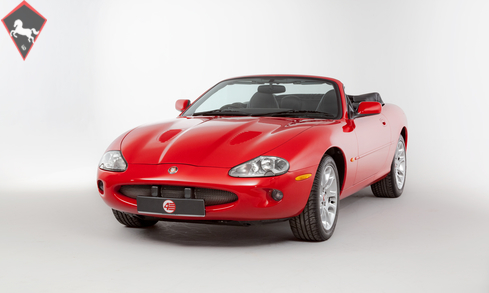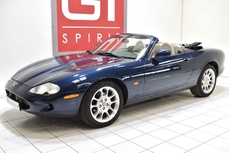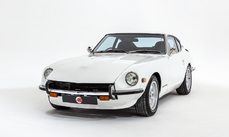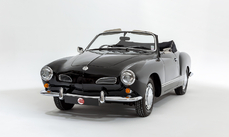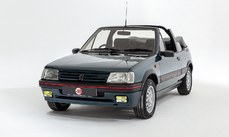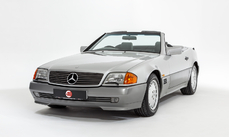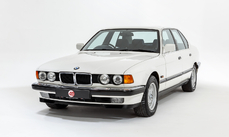Jaguar XKR Cabriolet 1999
General description :
Model History
In 1996, after over 20 years of successful production of the XJS, Jaguar launched the result of Project X100 - the XK8. Based on the XJS floorpan, Geoff Nicholson and his team designed a more curvaceous and aerodynamic Grand Tourer harking back in style to the E-Type and XJ220. The power unit was Jaguar’s first production V8 boasting a 4-litre capacity with 290hp. The German ZF 5-speed automatic gearbox was fitted along with new front and rear suspension plus an optional electrically controlled adaptive damping system (CATS). ABS and PAS were standard, and from 1998 automatic headlamp switching, auto-dipping rear view mirror and a security immobiliser were included. The car was available in both coupé and convertible versions.
In 1998 the supercharged XKR was introduced producing 370hp from the 4-litre engine. The supercharger was manufactured by Eaton and displaced at 2-litres. It generated 11.9 pounds of boost pressure to contribute to the higher power output. Externally the XKR can be distinguished from the XK8 by its mesh front grille, rear spoiler, and bonnet louvres that improved airflow to the engine. 18-inch alloy wheels and Sports seats were standard fitment.
The X100 XK8 was replaced by the X150 XK in 2007, with the new XKR appearing in 2012.
Equipment
Phoenix Red paintwork, 18-inch ‘Double Five’ alloy wheels, Electric folding soft-top in black, Charcoal Leather ‘Sport’ upholstery, Electrically-adjustable front seats, Cruise control, Stainless steel exhaust system, Automatic headlights, Driver’s Pack: Electrochromic and electric-folding door mirrors, Rain sensing wipers; Suspension with adaptive damping (CATS), Front fog lamps, Headlamp power wash, Jaguar cassette radio with 6 CD changer, Automatic climate control, Electric front and rear windows, Electrochromic rear view mirror, Remote central locking, Space saver spare wheel, Jaguar touch-up stick, Warning triangle, Jaguar carpet mats, Spare key.
Exterior
This gleaming Phoenix Red XKR has driven just 9,100 miles from new, and it shows! The paintwork presents in first-rate condition all round, and aside from just one or two very minor chips on the bonnet there are no scratches, scrapes, or dings to report. Everything appears just as it did leaving the factory, including all rubbers, trims, glass, and lights. The car has always been carefully stored when not in use and so the electric-folding soft-top is also perfectly preserved. All in all, an outstanding collector’s piece.
Interior
The welcoming Charcoal upholstery looks as good as new. The driver’s seat presents with hardly even a wrinkle and the remaining leather appears untouched throughout. There are no marks or signs of any wear to the armrest or centre console, and the steering wheel still looks factory-fresh. The glossy wood inlays are also perfect having never been damaged by the sun or blemished in any way.
The XKR is well specified with electrically-adjustable Sports seats, auto lights, auto wipers, cruise control, and a CD changer in the boot. Everything works exactly as it should with no signs of use to any of the switchgear, all of which still feels solid to operate. In the footwells you’ll find the original Jaguar overmats.
ENGINE & TRANSMISSION
The supercharged V8 is barely run-in with a mere 9k miles from new. The car has only ever been serviced at Jaguar, with the most recent service having been carried out in June 2019 at 9,065 miles; this was a major service that included brake fluid and spark plugs. Under the bonnet the engine bay is extremely well presented, not overly dressed but in excellent original condition throughout.
WHEELS, TYRES & BRAKES
The 18-inch ‘Double Five’ alloys present beautifully without a curb mark in sight; remarkably they have never been refurbished. The Jaguar centre badges appear as new and look great against the Phoenix Red paintwork. The wheels are wrapped in a matching set of Pirelli tyres, all with at least 4mm of tread remaining. With little over 10% of wear to report the brakes do a fine job of stopping the car quickly and in a straight line; the brake fluid was replaced in June 2019.
History File
The XKR was first registered in April 1999. The current owner of 12 years has only ever had the car serviced at Jaguar, with all visits recorded in the original maintenance booklet. It has been serviced five times, all with the same main dealer. The most recent service was done in June 2019, just 35 miles ago. The brake fluid and spark plugs were changed at this time and the car was given an entirely clean bill of health. The History File is complete with a raft of Jaguar invoices, stack of MOT certificates, all original manuals in the leather document pack, and a spare key with remote fob. The MOT is valid until June 2020.
http://www.4starclassics.com/for-sale/jaguar-xkr-cabriolet-for-sale/
1999 Jaguar XKR Cabriolet is listed sold on ClassicDigest in Kingsley by 4 Star Classics for £27495.
Car Facts
Car type : Car Make : Jaguar Model : XKR Model Version : Cabriolet Engine size : 4.0 Model Year : 1999 Sub type : Convertible Location : Hampshire
Sold
Seller Information
Sold
People who viewed this Jaguar XKR also viewed similar Jaguar listed at ClassicDigest
Other cars listed for sale by this dealer
About Jaguar
Ah, the story of Jaguar, from its early days as the SS Cars Ltd. to its pinnacle with the D-type, and the street-going evolution in the form of the iconic E-type. There's something quintessentially British about this tale, and I'll narrate it as a British journalist might.In the Beginnings:
Our journey into the world of Jaguar begins in the 1930s, when a company known as SS Cars Ltd. emerged. Despite the unfortunate coincidence of their initials with the rising political tensions in Europe, they started producing stylish and performance-oriented cars. The SS 100, introduced in 1936, was a symbol of elegance and speed, setting the stage for what would become Jaguar.
The Birth of Jaguar:
As the shadows of World War II loomed, SS Cars Ltd. wisely decided to disassociate themselves from the SS initials. Thus, in 1945, they officially became Jaguar Cars Ltd., a name that would soon be synonymous with British luxury and performance.
The XK Series:
Jaguar's post-war era brought us the XK 120, a true sensation in 1948. With its sleek design and a powerful 3.4-liter inline-six engine, it became the world's fastest production car. The XK 120 was the blueprint for what lay ahead – Jaguars that blended style with speed in a uniquely British fashion.
The D-type Dominance:
Then came the D-type, a true racing legend. Introduced in 1954, it won Le Mans three times in the 1950s, showcasing Jaguar's engineering prowess. With its innovative monocoque construction and the iconic fin at the back, the D-type was the apex of Jaguar's motorsport success.
The E-type Emergence:
But the true turning point arrived in 1961 with the introduction of the E-type, often described by Enzo Ferrari as "the most beautiful car ever made." Its long bonnet, curvaceous body, and a 3.8-liter engine delivering exhilarating performance made it an instant classic. The E-type was not just a car; it was a work of art on wheels, and it could hit 150 mph on the road.
Street and Racing Success:
The E-type's beauty was matched by its capability on the track. The lightweight E-types were particularly successful in various racing events, cementing Jaguar's reputation as a force to be reckoned with in motorsport.
The Age of Refinement:
As we delve deeper into the Jaguar story, we find that the 1950s and 1960s were an age of refinement and expansion. Alongside the magnificent D-type and the E-type's iconic emergence, Jaguar introduced models that further solidified its reputation for luxury and performance.
The MK2:
In the late 1950s, Jaguar unveiled the MK2, a sports sedan that combined elegance with power. This sleek four-door saloon was a favorite of bank robbers and law enforcement alike, thanks to its exceptional speed and handling. The MK2 was a symbol of Jaguar's ability to blend sophistication with performance and had a successful racing career as well.
The XJ6:
Fast forward to 1968, and Jaguar launched a car that would define luxury saloons for decades to come – the XJ6. It was a masterpiece of engineering and design, featuring a smooth inline-six engine, independent rear suspension, and a spacious, beautifully appointed interior. The XJ6 was a symbol of British elegance and provided a ride so smooth that it seemed to glide over the road. It became the flagship model for Jaguar and set the standard for luxury saloons, showcasing a level of refinement that left competitors in awe.
The Blend of Classic and Modern:
While the MK2 and XJ6 represented the evolution of Jaguar's saloon cars, they maintained the brand's commitment to performance and luxury. These cars didn't just belong on the racetrack; they were equally at home cruising down the grand boulevards or gliding through the English countryside.
The Challenges of Change:
However, as the 1970s arrived, Jaguar, like many British automakers, faced financial challenges and changes in ownership. The British Leyland era brought both opportunities and struggles, as the brand navigated through various mergers and transitions.
Nevertheless, the legacy of the MK2 and XJ6, along with the D-type and E-type, continues to define Jaguar as a manufacturer that combines timeless elegance with a spirit of performance. These classic models, whether driven on winding roads or parked as collectors' treasures, serve as a testament to Jaguar's enduring presence in the world of automotive excellence.
The Jaguar story, from its early days as SS Cars Ltd. to the creation of automotive icons like the E-type, MK2, and XJ6, is a journey that reflects the very essence of British motoring – a blend of luxury, power, and style that continues to captivate enthusiasts and connoisseurs alike.
